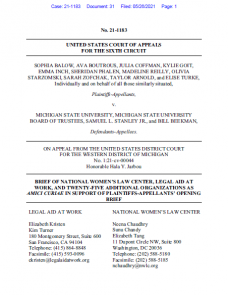Abortion rights, women of color, and LGBTQIA+ people are under attack. Pledge to join us in fighting for gender justice.
*** Victory! Update! ***
Court Decision: On February 1, 2022, the Sixth Circuit vacated the lower court’s decision and remanded for further proceedings consistent with the following corrections: First, there is no “magic number” for Title IX athletics compliance, and the lower court clearly erred in assuming that MSU was compliant with Title IX solely because its athletics participation gap was less than 2%. Second, the lower court clearly erred in comparing MSU’s participation gap to the size of the average women’s team at MSU instead of to the size of a viable team. Finally, publicly available athletics data reported by schools is acceptable at the preliminary injunction stage, the lower court clearly erred in rejecting the plaintiffs’ calculations of MSU’s large participation gap based on MSU’s own reported, publicly available data. This decision is a great win because it provides important clarifications on what standards courts must apply when evaluating whether a school’s athletics program is compliant with Title IX. On remand, the lower court granted the Sophia and her teammates’ request to stop MSU from cutting their team. MSU then asked the Supreme Court to weigh in, but the Court declined to consider it.
Settlement: On January 13, 2023, the parties reached a settlement agreement that prohibits MSU from cutting any women’s team from now until the end of the 2029-30 school year. The agreement also requires MSU’s athletic program to come into full Title IX compliance by the end of the 2026-27 school year, including by requiring the appointment of an independent Gender Equity Review Director and the creation of a Gender Equity Plan.
***
On May 26, 2021, NWLC, along with co-counsel Legal Aid At Work and Simpson Thacher & Bartlett LLP, led a group of 25 other organizations to file an amicus brief in the Sixth Circuit in Balow v. Michigan State University in support of eleven members of MSU’s women’s varsity swim and diving team. In February 2021, a federal court in Michigan denied the plaintiffs’ request to stop MSU from eliminating their team at the end of the 2020-21 season.
As background, one way for a school’s athletics program to comply with Title IX is to ensure that the total number of spots on all sports teams for each gender is proportionate to each gender’s enrollment. If these numbers are not proportionate, then the school has a “participation gap.” If the participation gap is sufficient to sustain a viable team, the school is out of compliance. MSU fails this test. By eliminating its women’s swimming and diving team, the school would exacerbate an already-unlawful participation gap and create one that is plainly large enough to sustain a viable team for women—namely, the very team seeking to stop the University from eliminating it.
In our brief, we explain that the district court made several errors when it ruled against the women’s team. First, the court incorrectly assumed that MSU is in compliance with Title IX solely because its participation gap is less than 2%, even though there is no such “magic number” under Title IX. Second, the court incorrectly compared MSU’s participation gap with the average size of all women’s sports teams at MSU, instead of with specific sports teams, like the women’s swim and diving team. Finally, the district court wrongly rejected the plaintiffs’ use of MSU’s self-reported, publicly available data and instead credited MSU’s claims about internal data that it never actually produced.
If this decision is not overturned, large schools will be able to deprive many women of athletics opportunities by invoking the 2% safe harbor, and all schools will be able to cut their smallest women’s teams to inflate their average team size, allowing them to have ever-larger participation gaps. Furthermore, when women and girls sue their schools for violating Title IX, schools will be rewarded for hiding their internal data from courts and plaintiffs.
Read our blog post to learn more.

